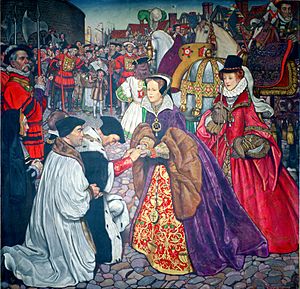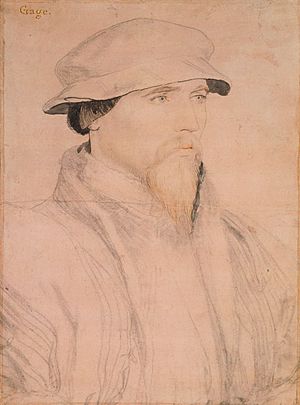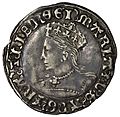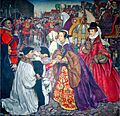Coronation of Mary I of England facts for kids
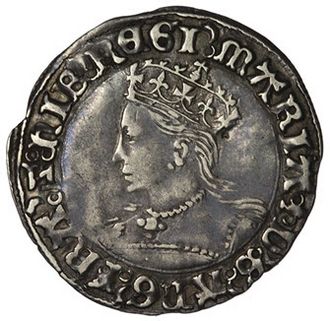
Mary I of England depicted crowned on her Groat
|
|
| Date | 1 October 1553 |
|---|---|
| Location | Westminster Abbey, London, England |
| Participants |
|
On Sunday, 1 October 1553, Mary I was crowned Queen of England and Ireland. This important event took place at Westminster Abbey in London. It was a very special day because Mary was the first queen regnant of England. This means she was a female ruler in her own right, not just the wife of a king. Because of this, the coronation ceremony had to be changed to fit a queen. Even though people said it followed old traditions, many parts were new for a queen ruling alone.
Contents
Becoming Queen: Mary's Journey to the Throne
Mary I was officially announced as queen on 19 July 1553. This happened after a period of political uncertainty. William Herbert, Earl of Pembroke, made the announcement. This decision meant that Lady Jane Grey's claim to the throne was set aside.
Many writers supported Mary's right to rule. Richard Taverner wrote a pamphlet celebrating her becoming queen. It explained why her claim was rightful. Other writers also shared ballads and poems. These works often compared Mary's peaceful rise to power to famous stories from the Bible. For example, some compared her to Judith and Esther, who were strong female figures.
There were no English books describing the coronation ceremony itself. However, descriptions were published in Italian and Spanish. These foreign accounts often matched what diplomats wrote. One Spanish report even estimated the cost of all the coronation events. It said they cost about 100,000 ducats, which was a huge amount of money back then.
Plays and Entertainment at the Coronation
The coronation celebrations included plans for plays and other entertainment. Records show that special fabrics were bought for costumes. One play was supposed to feature a good angel, a bad angel, and a character called Genus Humanum (meaning "Human Race"). This play aimed to show the problems faced by people, like sickness and weakness. It also showed how good qualities, like reason and truth, could help. These good qualities were likely meant to represent Mary's court and her kingdom.

It's not clear if the Genus Humanum play was actually performed at the coronation. Mary had given permission for a play on 26 September. However, costume records suggest the performance might have been moved to Christmas.
Another play, called Respublica, was written for Christmas that year. It explored ideas about Mary becoming queen and her relationship with Parliament. In this play, Mary was honored as "Verity, the daughter of sage old Father Time." This connects to Mary's own motto, Veritas Filia Temporis, meaning "Truth is the Daughter of Time." This idea of "Truth" was important to Mary, especially in contrast to the Protestant reformers of the time.
Mary's Grand Entry into London
Before her coronation, Mary made a special journey into London. She had been staying at Kenninghall in Norfolk and Framlingham in Suffolk. In Ipswich, children gave her a golden heart as a gift. She also met her sister, Princess Elizabeth, at Wanstead. Elizabeth arrived in London on 29 August with many people and guards.
Mary rode into London on 3 August 1553. She wore a beautiful violet velvet outfit. Later, she changed into a rich purple velvet gown. This gown was covered in gold work and large pearls. She entered the city through Aldgate. At St Botolph's Aldgate, children from Christ's Hospital, a charity school, performed for her. Some accounts say Mary didn't seem to notice them. However, others say she listened carefully to a speech given by a young Edmund Campion.
Mary made another, more formal, entry into London on 30 September. This was the day before her coronation.
Coronation Eve Preparations
On 28 September 1553, Mary traveled by boat from St James' Palace to the Tower of London. As she went down the River Thames, many decorated boats greeted her. The Lord Mayor of London and city officials were on board. When she neared the Tower, the guards fired a gun salute.
Special clothes were made for Mary and her ladies for the evening before the coronation. Mary's robe was made of gold and silver fabric. This evening was also when the Knights of the Bath prepared for the ceremony. They followed an old English tradition of bathing at the Tower of London on 29 September. The next morning, new knights were honored by the Earl of Arundel, who was in charge of Mary's household.
Some historians believe that Mary's special clothes from this time were later used by Elizabeth I at her own coronation. They might even be seen in portraits of Elizabeth.
The Coronation Procession
Mary's grand procession through London happened on the afternoon of 30 September. She rode from the Tower of London to the Palace of Westminster in a special carriage. Princess Elizabeth and Anne of Cleves rode in another carriage. They wore silver clothes with French-style gowns. Four ladies-in-waiting rode on horses next to Mary's carriage. These included the Duchess of Norfolk and the Marchioness of Exeter.
More noblewomen and gentlewomen followed on horseback. They wore crimson satin. The maids of honour, like Anne Basset and Anne Dormer, were also part of the procession. In total, there were between 46 and 60 women riding horses. The windows of houses along the route were decorated with beautiful tapestries and rich fabrics.
The procession featured many exciting displays with music and speeches. At Fenchurch Street, merchants from Genoa had a welcome display. A young actor, dressed as a girl, sat on a chair suspended in the air. There were also four giants. Latin messages on the arches were noted by diplomats.
Hanse merchants created their own display at Gracechurch Corner. It had a small mountain and a fountain that flowed with wine. An actor even "flew down a rope" as the queen passed by! Florentine merchants built an arch with three entrances. Six actors welcomed Mary from above, and a statue of an angel played a trumpet. This display showed Queen Tomyris and Judith. It seemed to celebrate Mary's recent success over the Duke of Northumberland.
The City of London also had a display at the Conduit in Cornhill. City officials stood by their display in Cheap, and the Recorder of London gave a speech. Near St Paul's school, John Heywood gave a speech in both Latin and English. At St Paul's Cathedral, a man named "Peter, a Dutchman," danced on the church steeple with streamers.
People who supported Mary wrote that the London streets were full of her fans. They threw their hats in the air and cheered, "Long live Queen Mary!"
The Coronation Ceremony
On 1 October, Mary arrived at Westminster Abbey by boat. As she walked from Westminster Hall to the Abbey, three swords were carried in front of her. Two swords represented Justice: Spiritual justice and Temporal justice. The third sword, called the curtana, was carried by the Earl of Derby. This sword represented Mercy. Princess Elizabeth and Anne of Cleves walked with Mary into the Abbey. Noblewomen walked in pairs, holding their small crowns.
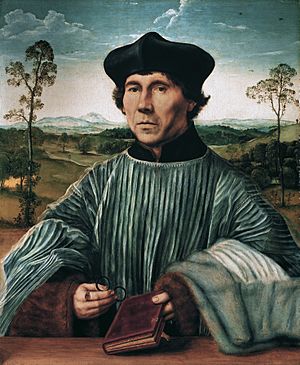
Mary's long train was carried by the Lord Chamberlain, John Gage, and the Duchess of Norfolk. The Abbey's choir area was decorated with tapestries, and the floor was covered with rushes. When Mary entered, the Bishop announced that the Queen would pardon prisoners. However, those who had supported Lady Jane Grey were not pardoned.
The Coronation Chair and Recognition
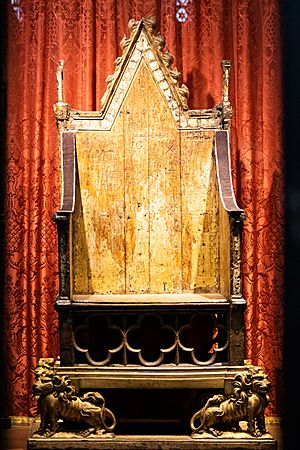
Mary was led to King Edward's chair by two noblemen. After a short rest, she joined Stephen Gardiner, Bishop of Winchester and Lord Chancellor, on a raised platform. This platform allowed everyone to see her. The chair was in the middle of the platform, covered with rich fabrics. One account says the chair was on a very high platform with ten steps. The chair itself was white, with carved lions and a fleur-de-lis (a lily symbol).
Mary showed herself at the four corners of the platform. Gardiner then introduced her as queen. This part of the ceremony is called "recognition." Gardiner asked the people if they agreed, and they all shouted, "God save Queen Mary!"
Anointing and the Traverse
Mary then went to a special chair near the main altar and made her offerings. George Day, Bishop of Chichester, gave a sermon about obedience. Mary made her promises, and the choir sang a hymn. For the anointing, Mary went into a "traverse." This was a private, curtained-off area. Here, her ladies helped her change clothes.
Inside the traverse, Mary was anointed with holy oil by Stephen Gardiner. This oil was specially obtained from a bishop because the oil from Edward VI's reign was not considered holy enough. Important noblemen held a canopy over her during the anointing. The canopy was supposed to be gold, but crimson satin embroidered with gold was used instead.
Three Crowns and Two Sceptres
The Duke of Norfolk brought three crowns: St Edward's Crown, the Imperial crown, and a new crown made for Mary. Gardiner crowned Mary three times. He also gave her a ring for her "marrying finger" and bracelets with jewels and pearls. The noblemen then put on their own small crowns.
Gardiner and the earls showed their respect to Mary. A church service was held while Mary knelt. She held the royal sceptre and another sceptre topped with a dove. She then went back into the private traverse and came out in her coronation robe. She carried the sceptre and monde or orb (a golden ball with a cross). The ceremony in the Abbey finished around four or five o'clock in the afternoon.
Coronation Banquet
After the long ceremony, a grand feast was held in Westminster Hall. Mary sat in the Coronation Chair in the hall. She even rested her feet on two of her ladies-in-waiting.
The Queen's Champion
During the banquet, the Queen's Champion, Edward Dymoke, rode into the hall in full armor. He threw down a glove, challenging anyone who dared to question Mary's right to be queen.
Dymoke's reward was a gold cup, which Mary gave to him filled with wine. He also received the horse and armor he wore, and special crimson satin clothes. He was given the food allowance of a baron.
Coronation Costumes
We know many details about the fabrics and clothes used for the coronation from royal records. These records include Mary's own orders for materials. Old written accounts and reports from diplomats also describe some of the clothing.
The French ambassador noted that Mary's court had changed. Her women now wore bright colors and jewelry, with wide sleeves in the French style. In 1554, a Venetian diplomat reported that Mary wore a gown and bodice with wide hanging sleeves for important events.
Crimson was a traditional color for English coronations. At the most important part of the ceremony, Mary changed into purple. This color was also mentioned by a writer named John Seton.
Two special squires wore crimson velvet mantles and hats. They represented the Duchy of Gascony and Guyenne, showing Mary's claim to these lands. Their costumes were old-fashioned on purpose.
One account says Mary wore a blue velvet gown lined with ermine fur on her way to the Abbey. Other accounts say she wore her Parliament robes of crimson velvet. A list of her clothes says she wore her "usual apparel" under her Parliament robes on the second day. Her collar was decorated with a special kind of woven lace called passamayne.
The Circlet
On her head, Mary wore a gold circlet decorated with jewels and pearls. She had worn this circlet the day before during her Royal Entry into London. Some old stories say Mary had trouble holding her heavy circlet and jeweled veil during the entry. This circlet was newly made for her.
Blue and Ray Cloth
The path from Westminster Hall to the Abbey was covered with blue velvet or multi-colored woollen "ray-cloth." The blue cloth was used between the hall and the Abbey choir door. The pulpit was draped with red worsted fabric.
Using ray cloth for the procession route was a tradition. At the coronation of Elizabeth of York in 1487, people rushed to cut pieces of the ray cloth as souvenirs. This caused some accidents.
Costume Changes During the Ceremony
During the ceremony, Mary went into a private, curtained space called a traverse. Here, she changed her clothes. She put on a purple velvet mantle and a purple velvet kirtle (a type of gown) with a train lined with ermine fur. Her ladies-in-waiting helped her. For the anointing, she wore a simple white silk garment called a Colobium Sindonis. After the anointing, she put on the purple velvet kirtle. Mistress Walgrave, the wife of Edward Waldegrave, helped her get dressed and gave her linen gloves. Her shoes were made of crimson cloth of gold. This costume change was carefully planned and detailed in records.
Mary paid for these new, fur-lined, and lace-decorated items herself. The earls and countesses at the ceremony wore crimson velvet and gold coronets.
Ladies' Attire
Mary's ladies of the household wore different fabrics based on their rank during the Royal Entry. They wore crimson damask, satin, and velvet. At the coronation itself, they wore scarlet (a type of wool), satin, and crimson velvet.
Scarlet gowns lined with "lettice" fur were made for several ladies, including Susan Clarencieux and Mary Finch. Lettice is a gray weasel fur. Some of these ladies were "chamberers," who served the queen closely.
Records also show costumes made for Will Somers and "Jane our woman foole" (a female jester). It's not clear if Jane's costume was for the coronation itself.
Elizabeth I Reuses Mary's Clothes
Many details of Mary's coronation costumes, including the fabrics and costume changes, were similar to her parents' coronation in 1509.
When Elizabeth I was crowned in 1559, she actually reused some of Mary's clothes. A tailor named Walter Fyshe altered them for her.
Historians have found that items in Elizabeth's inventory match descriptions of Mary's coronation wardrobe. This includes a gold and silver mantle and matching kirtle used for the Royal Entry. It also includes the purple velvet mantle, kirtle, and surcoat worn in the Abbey after the anointing.
Some of Mary's gowns stayed in Elizabeth's wardrobe for many years. These included purple gowns and one made of crimson satin with pearls and garnets. It's thought that Mary might have worn the crimson satin gown with pearls at her wedding to Philip of Spain in Winchester.
Images for kids
-
Mary I of England depicted crowned on her Groat
-
Mary I of England enthroned by angels depicted on a 1553 plea roll, with flowing hair.
-
Royal Entry of Queen Mary I with Princess Elizabeth into London in a 1910 painting by Byam Shaw
-
John Gage helped the Duchess of Norfolk carry Mary's train into Westminster Abbey
-
Edward Stanley, 3rd Earl of Derby carried the sword "curtana" symbolic of Mercy
-
Mary was crowned by Stephen Gardiner
-
Mary was first seated in the Abbey in King Edward's chair
-
Some of Mary's gentlewomen and chamberers wore scarlet cloth gowns trimmed with "lettice", the winter fur of a weasel
-
Elizabeth I used some of Mary's coronation clothes at her coronation in 1559


